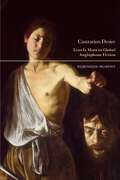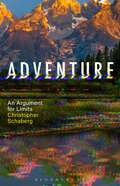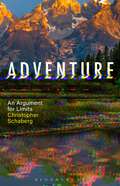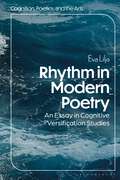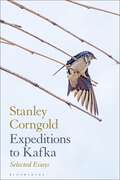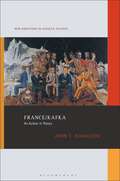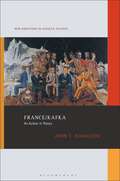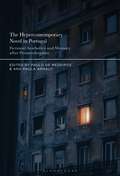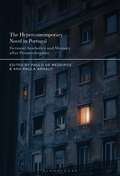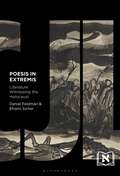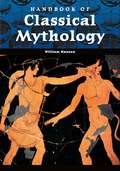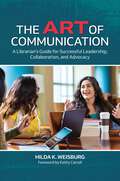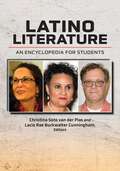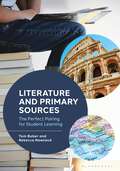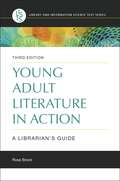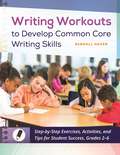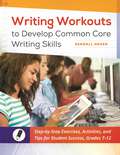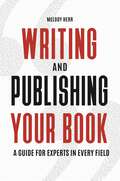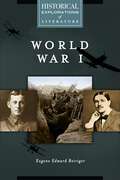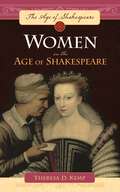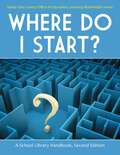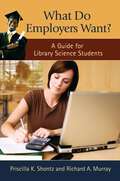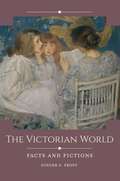- Table View
- List View
Castration Desire: Less Is More in Global Anglophone Fiction
by Prof. or Dr. Robinson MurphyTheorizes an alternative form of masculinity in global literature that is less egocentric and more sustainable, both in terms of gendered and environmental power dynamics.Contemporary novelists and filmmakers like Kazuo Ishiguro (Japanese-British), Emma Donoghue (Irish-Canadian), Michael Ondaatje (Sri Lankan-Canadian), Bong Joon-ho (South Korean) and J.M. Coetzee (South African-Australian) are emblematic of a transnational phenomenon that Robinson Murphy calls “castration desire.” That is, these artists present privileged characters who nonetheless pursue their own diminishment. In promulgating through their characters a less egocentric mode of thinking and acting, these artists offer a blueprint for engendering a more other-oriented global relationality. Murphy proposes that, in addition to being an ethical prerogative, castration desire's “less is more” model of relationality would make life livable where veritable suicide is our species' otherwise potential fate. “Castration desire” thus offers an antidote to rapacious extractivism, with the ambition of instilling a sustainable model for thinking and acting on an imminently eco-apocalyptic earth.In providing a fresh optic through which to read a diversity of text-types, Castration Desire helps define where literary criticism is now and where it is headed. Castration Desire additionally extends and develops a zeitgeist currently unfolding in critical theory. It brings Leo Bersani's concept “psychic utopia” together with Judith Butler's “radical egalitarianism,” but transports their shared critique of phallic individualization into the environmental humanities. In doing so, this book builds a new framework for how gender studies intersects with environmental studies.
Adventure: An Argument for Limits
by Dr. Christopher SchabergWhat is the meaning of “adventure” as we enter the third decade of the 21st century, after a global pandemic, social and geopolitical calamities, and accelerating environmental catastrophes? What stories are humans telling about wilderness, remote destinations, and the most difficult thoughts thinkable? Adventure is a pinball assortment of unexpected encounters. Each chapter entertains a specific project, fantasy, or activity that dabbles with adventure – and runs into limits. Subjects range from Mars exploration, commercial space tourism, and adventure consumerism, to the day-to-day experiences of living in a world increasingly impacted by climate change and environmental disasters.Taking a wide-angle view – at times personal, at others theoretical – Schaberg explores our ideas about adventure and their narrative, cultural, and philosophical underpinnings.
Adventure: An Argument for Limits
by Dr. Christopher SchabergWhat is the meaning of “adventure” as we enter the third decade of the 21st century, after a global pandemic, social and geopolitical calamities, and accelerating environmental catastrophes? What stories are humans telling about wilderness, remote destinations, and the most difficult thoughts thinkable? Adventure is a pinball assortment of unexpected encounters. Each chapter entertains a specific project, fantasy, or activity that dabbles with adventure – and runs into limits. Subjects range from Mars exploration, commercial space tourism, and adventure consumerism, to the day-to-day experiences of living in a world increasingly impacted by climate change and environmental disasters.Taking a wide-angle view – at times personal, at others theoretical – Schaberg explores our ideas about adventure and their narrative, cultural, and philosophical underpinnings.
Rhythm in Modern Poetry: An Essay in Cognitive Versification Studies (Cognition, Poetics, and the Arts)
by Professor Emerit Eva LiljaA pioneering work in cognitive versification studies, scrutinizing the rhythmical means of free verse.Investigating a previously neglected area of study, Rhythm in Modern Poetry establishes a foundation for cognitive versification studies with a focus on the modernist free verse. Following in the tradition of cognitive poetics by Reuven Tsur, Richard Cureton and Derek Attridge, every chapter investigates the rhythms of one modern poem, by Lawrence Ferlinghetti, Sylvia Plath and others, and engages each element in the broader interpretation of the poem in question. In her examination of modernist poetry in English and other Germanic languages, Eva Lilja expands her analysis to discuss both the Ancient Greek and Norse origins of rhythm in free verse and the intermedia intersection, comparing poetic rhythm with rhythm in pictures, sculptures and dance. Rhythm in Modern Poetry thus expands the field of cognitive versification studies while also engaging readers writ large interested in how rhythm works in the aesthetic field.
Expeditions to Kafka: Selected Essays
by Professor or Dr. Stanley CorngoldIn this new volume of Kafka studies, which is addressed to both beginning readers of Kafka as well as Kafka scholars, Stanley Corngold discusses Kafka's work in a variety of novel perspectives, including Goethe's The Sufferings of Young Werther; Nietzsche's conception of aphoristic form; bureaucratic organization; accident and risk; the logic of possession and inheritance; and myth, among others.Even as Corngold explores Kafka's work across different fields and tangents, he does so in vivid, readable prose, free of jargon, and with an eye to Kafka's ongoing relevance to the concerns of his day and ours. Taken together these linked essays reveal Kafka in his astonishing many-sidedness.
Expeditions to Kafka: Selected Essays
by Professor or Dr. Stanley CorngoldIn this new volume of Kafka studies, which is addressed to both beginning readers of Kafka as well as Kafka scholars, Stanley Corngold discusses Kafka's work in a variety of novel perspectives, including Goethe's The Sufferings of Young Werther; Nietzsche's conception of aphoristic form; bureaucratic organization; accident and risk; the logic of possession and inheritance; and myth, among others.Even as Corngold explores Kafka's work across different fields and tangents, he does so in vivid, readable prose, free of jargon, and with an eye to Kafka's ongoing relevance to the concerns of his day and ours. Taken together these linked essays reveal Kafka in his astonishing many-sidedness.
France/Kafka: An Author in Theory (New Directions in German Studies)
by John T. HamiltonWhile his memory languished under Nazi censorship, Franz Kafka covertly circulated through occupied France and soon emerged as a cultural icon, read by the most influential intellectuals of the time as a prophet of the rampant bureaucracy, totalitarian oppression, and absurdity that branded the twentieth century. In tracing the history of Kafka's reception in postwar France, John T. Hamilton explores how the work of a German-Jewish writer from Prague became a modern classic capable of addressing universal themes of the human condition.Hamilton also considers how Kafka's unique literary corpus came to stimulate reflection in diverse movements, critical approaches, and philosophical schools, from surrealism and existentialism through psychoanalysis, phenomenology, and structuralism to Marxism, deconstruction, and feminism. The story of Kafka's afterlife in Paris thus furnishes a key chapter in the unfolding of French theory, which continues to guide how we read literature and understand its relationship to the world.
France/Kafka: An Author in Theory (New Directions in German Studies)
by John T. HamiltonWhile his memory languished under Nazi censorship, Franz Kafka covertly circulated through occupied France and soon emerged as a cultural icon, read by the most influential intellectuals of the time as a prophet of the rampant bureaucracy, totalitarian oppression, and absurdity that branded the twentieth century. In tracing the history of Kafka's reception in postwar France, John T. Hamilton explores how the work of a German-Jewish writer from Prague became a modern classic capable of addressing universal themes of the human condition.Hamilton also considers how Kafka's unique literary corpus came to stimulate reflection in diverse movements, critical approaches, and philosophical schools, from surrealism and existentialism through psychoanalysis, phenomenology, and structuralism to Marxism, deconstruction, and feminism. The story of Kafka's afterlife in Paris thus furnishes a key chapter in the unfolding of French theory, which continues to guide how we read literature and understand its relationship to the world.
The Hypercontemporary Novel in Portugal: Fictional Aesthetics and Memory after Postmodernism
The first volume of critical essays on the contemporary Portuguese novel in English, this book theorizes the concept of the 'hypercontemporary' as a way of reading the novel after its postmodern period. This inquiry into the notion of the hypercontemporary in its literary and cultural articulations analyzes a varied group of works representative of the most vibrant novels published in Portugal since 2000. The editors' introductory chapter theorizes the concept of the hypercontemporary as one way of looking at the novel after its postmodern period – especially in its relation to questions of violence, memory and performativity. These essays show how the Portuguese novel has evolved in the past 25 years, and how, in their diversity, most of these novels exhibit several common traits, including new topics and writing strategies – sometimes developing further entropic lines characteristic of many Postmodern narratives – and themes of violence, rapid transformation, and the many threats to a contemporary world that seems mass-produced due to greater technological advances. Readings also discuss the use of innovative graphic forms available from current print technologies and global networks. The Hypercontemporary Novel in Portugal provides a necessary understanding of the current literary landscape of Portugal and, in the process, the aesthetics of hyperrealism or post-postmodernism.
The Hypercontemporary Novel in Portugal: Fictional Aesthetics and Memory after Postmodernism
by Paulo de Medeiros and Ana Paula ArnautThe first volume of critical essays on the contemporary Portuguese novel in English, this book theorizes the concept of the 'hypercontemporary' as a way of reading the novel after its postmodern period. This inquiry into the notion of the hypercontemporary in its literary and cultural articulations analyzes a varied group of works representative of the most vibrant novels published in Portugal since 2000. The editors' introductory chapter theorizes the concept of the hypercontemporary as one way of looking at the novel after its postmodern period – especially in its relation to questions of violence, memory and performativity. These essays show how the Portuguese novel has evolved in the past 25 years, and how, in their diversity, most of these novels exhibit several common traits, including new topics and writing strategies – sometimes developing further entropic lines characteristic of many Postmodern narratives – and themes of violence, rapid transformation, and the many threats to a contemporary world that seems mass-produced due to greater technological advances. Readings also discuss the use of innovative graphic forms available from current print technologies and global networks. The Hypercontemporary Novel in Portugal provides a necessary understanding of the current literary landscape of Portugal and, in the process, the aesthetics of hyperrealism or post-postmodernism.
Poesis in Extremis: Literature Witnessing the Holocaust (Comparative Jewish Literatures)
by Prof. or Dr. Daniel Feldman Prof. or Dr. Efraim SicherHow can genocide be witnessed through imaginative literature? How can the Holocaust affect readers who were not there?Reading the work of major figures such as Elie Wiesel, Paul Celan, Avrom Sutzkever, Ida Fink, Wladyslaw Szlengel, Itzhak Katzenelson, and Czeslaw Milosz, Poesis in Extremis poses fundamental questions about how prose and poetry are written under extreme conditions, either in real time or immediately after the Holocaust. Framed by discussion of literary testimony, with Wiesel's literary memoir Night as an entry point, this innovative study explores the blurred boundary of fact and fiction in Holocaust literature. It asks whether there is a poetics of the Holocaust and what might be the criteria for literary witnessing. Wartime writing in particular tests the limits of “poesis in extremis” when poets faced their own annihilation and wrote in the hope that their words, like a message in a bottle, would somehow reach readers. Through Poesis in Extremis, Daniel Feldman and Efraim Sicher probe the boundaries of Holocaust literature, as well as the limits of representation.
Poesis in Extremis: Literature Witnessing the Holocaust (Comparative Jewish Literatures)
by Prof. or Dr. Daniel Feldman Prof. or Dr. Efraim SicherHow can genocide be witnessed through imaginative literature? How can the Holocaust affect readers who were not there?Reading the work of major figures such as Elie Wiesel, Paul Celan, Avrom Sutzkever, Ida Fink, Wladyslaw Szlengel, Itzhak Katzenelson, and Czeslaw Milosz, Poesis in Extremis poses fundamental questions about how prose and poetry are written under extreme conditions, either in real time or immediately after the Holocaust. Framed by discussion of literary testimony, with Wiesel's literary memoir Night as an entry point, this innovative study explores the blurred boundary of fact and fiction in Holocaust literature. It asks whether there is a poetics of the Holocaust and what might be the criteria for literary witnessing. Wartime writing in particular tests the limits of “poesis in extremis” when poets faced their own annihilation and wrote in the hope that their words, like a message in a bottle, would somehow reach readers. Through Poesis in Extremis, Daniel Feldman and Efraim Sicher probe the boundaries of Holocaust literature, as well as the limits of representation.
Handbook of Classical Mythology (World Mythology)
by William F. HansenAn introduction to the mythological world of the Greeks and the Romans, combined with a chronology of myths and a dictionary of key characters, objects, and events.Handbook of Classical Mythology offers newcomers and long-time enthusiasts new ways to navigate the world of Greek and Roman myths. Written by a foremost mythologist, the book begins by exploring the sources and landscapes from which the myths emerged. It then provides a richly detailed timeline of mythic episodes from the creation of the cosmos to the end of the Heroic Age—plus an illustrated mythological dictionary listing every significant character, place, event, and object.Whether exploring the world that gave rise to ancient mythology or researching a specific piece of the whole, the handbook is the best introduction available to the extraordinary cast of these tales (gods, nymphs, satyrs, monsters, heroes) and the natural and supernatural stages upon which their fates are played out.
The Art of Communication: A Librarian's Guide for Successful Leadership, Collaboration, and Advocacy
by Hilda K. WeisburgLibrarians will learn communication skills that help them develop as leaders, build community, and advocate for their libraries.Librarians understand the importance of making the value of the library known to stakeholders. In this informative and conversational book, Hilda K. Weisburg gradually builds librarians' communication skills, which are intrinsic to the success of library programs and services. Being able to effectively communicate as a sender and receiver of messages is a vital leadership skill, and librarians must master all the multi-faceted ways people exchange information in order to grow as leaders.Throughout the book, librarians will learn communication basics and the obstacles that interfere with successful communication. The chapters in part one detail the three components of communication; part two prepares librarians to cope with difficult communications; and part three gives librarians further techniques to ensure their messages are cohesive and strategic as they reach out to stakeholders.The book's goal is for librarians to feel confident about using their newly learned communication skills for advocacy. As their value to the library community grows, they will be able to strategically use the relationships their communications have built to create positive change.
Latino Literature: An Encyclopedia for Students
by Christina Soto van der Plas and Lacie Rae Buckwalter CunninghamOffers a comprehensive overview of the most important authors, movements, genres, and historical turning points in Latino literature.More than 60 million Latinos currently live in the United States. Yet contributions from writers who trace their heritage to the Caribbean, Central and South America, and Mexico have and continue to be overlooked by critics and general audiences alike. Latino Literature: An Encyclopedia for Students gathers the best from these authors and presents them to readers in an informed and accessible way. Intended to be a useful resource for students, this volume introduces the key figures and genres central to Latino literature. Entries are written by prominent and emerging scholars and are comprehensive in their coverage of the 19th, 20th, and 21st centuries. Different critical approaches inform and interpret the myriad complexities of Latino literary production over the last several hundred years. Finally, detailed historical and cultural accounts of Latino diasporas also enrich readers' understandings of the writings that have and continue to be influenced by changes in cultural geography, providing readers with the information they need to appreciate a body of work that will continue to flourish in and alongside Latino communities.
Literature and Primary Sources: The Perfect Pairing for Student Learning
by Tom Bober Rebecca NewlandEnrich student engagement and deepen learning with this guide to foolproof techniques and strategies to integrate primary sources and literature to benefit learners from kindergarten through high school.Readers of all ages experience literature in a different light when historical context is provided via primary sources. Literature, meanwhile, helps learners to uncover additional layers of meaning inherent in primary sources. Guided by best practices developed by the authors over years of working with both students and teachers, this book speaks to the countless opportunities for instructors to integrate related primary sources with the literature that students read in school classrooms-from historical fiction and poetry to graphic novels.
Young Adult Literature in Action: A Librarian's Guide (Library and Information Science Text Series)
by Rose BrockTaking a genre approach, this overview of young adult literature shows new librarians and library science students the criteria to use for selecting quality books, including recommended titles.This third edition of Young Adult Literature in Action draws on the success of the previous two editions authored by Rosemary Chance, updating and expanding on them to meet the needs of today's librarians and library science students. It includes a new focus on diverse books, LGBTQ+ selections, the role of book formats, and the relevance of librarians serving teen populations and is an ideal resource for teaching young adult literature courses.Organized by major genre divisions, this easy-to-use book includes new information on timely topics such as audio and e-books, accessible books, and graphic novels. Each chapter includes revised and updated information on collaborative activities, featured books, special topics and programs, selected awards and celebrations, historical connections, recommended resources, issues for discussion, author comments, and assignment suggestions. Further updates include citations of exemplary young adult books and award winners, references, websites, and a bibliography.
Writing Workouts to Develop Common Core Writing Skills: Step-by-Step Exercises, Activities, and Tips for Student Success, Grades 2–6
by Kendall HavenThis book is a "best of" collection of tips and exercises to help nurture young writers and strengthen core skills. Since each activity has been tried and tested in thousands of classrooms, you'll find successful methods for turning even the most reluctant students into effective, powerful writers.Writing proficiency is more important than ever, especially with the demands of standardized testing and the rigors of new standards impacting our schools. This classroom-tested manual, created from a combination of the author's extensive in-class experience and acclaimed research in neural science and developmental biology, addresses all facets of writing competency. The content links to common core curriculum elements in state language arts standards for every state.Written by experienced educator and author Kendall Haven, the work features 13 innovative writing tips and 30 engaging activities for helping students become better writers. The first part of the book covers writing hints and techniques, while the second half contains core content activities for coaxing the best writing out of your students. A short introductory section lays out the five steps of effective student writing. Lastly, the text reveals how teachers—even those from non-literary backgrounds—can successfully teach and grade writing.
Writing Workouts to Develop Common Core Writing Skills: Step-by-Step Exercises, Activities, and Tips for Student Success, Grades 7–12
by Kendall HavenThis book is a "best of" collection of tips and exercises to help nurture young writers and strengthen core skills. Since each activity has been tried and tested in thousands of classrooms, you'll find successful methods for turning even the most reluctant students into effective, powerful writers.Writing proficiency is more important than ever, especially with the demands of standardized testing and the rigors of new standards impacting our schools. This classroom-tested manual, created from a combination of the author's extensive in-class experience and acclaimed research in neural science and developmental biology, addresses all facets of writing competency. The content links to common core curriculum elements in state language arts standards for every state.Written by experienced educator and author Kendall Haven, the work features 13 innovative writing tips and 30 engaging activities for helping students become better writers. The first part of the book covers writing hints and techniques, while the second half contains core content activities for coaxing the best writing out of your students. A short introductory section lays out the five steps of effective student writing. Lastly, the text reveals how teachers—even those from non-literary backgrounds—can successfully teach and grade writing.
Writing and Publishing Your Book: A Guide for Experts in Every Field
by Melody Herr Ph.D.Are you ready to write your book? Partner with an experienced publisher, writing coach, and author and find out how to turn your research and scholarship into a book.This book is the next-best-thing to a personal writing coach. Drawing upon her own extensive experience as an author and publisher, Melody Herr guides the reader through every step of the writing and publishing process: constructing a table of contents, preparing a proposal, finding a publisher, negotiating a contract, drafting the manuscript, and marketing the finished product. Throughout, she offers proven strategies for producing a book that highlights its author's authoritative knowledge and writing skills. Unique among writing guides, Writing and Publishing Your Book: A Guide for Experts in Every Field acknowledges the reader's own expertise; speaks to researchers and scholars across the sciences, social sciences, and humanities; and provides information and guidance that will benefit junior authors as well as their more senior colleagues. By following these practical, step-by-step instructions, new authors will more easily liberate their own creativity while avoiding the many pitfalls that mire new writers, thereby maintaining momentum for a successful publication.
World War I: A Historical Exploration of Literature (Historical Explorations of Literature)
by Eugene Edward BeirigerFocusing on the war on the Western and Southern fronts and inclusive of material from all sides of the conflict, this book explores the novels and poems of significant soldier-writers alongside important contemporary historical documents.The literary works of the First World War are one of the richest sources we have for understanding one of the twentieth century's most significant conflicts. Not only do many of them have historical merit, but some were critically acclaimed by both contemporaries and subsequent scholars. For example, Henri Barbusse's Under Fire, one of the earliest novels of the war, won accolades in France and the respect of war poets Siegfried Sassoon and Wilfred Owen as well as novelists Erich Maria Remarque and Ernest Hemingway.This book examines these works and those of war poets Rupert Brooke and John McCrae and others, providing context as well as opportunities to explore thematic elements with primary source documents, such as diaries, letters, memoirs, newspaper and journal articles, speeches, and government publications. It is unique in its use of literary and historical sources as mediums by which to both better understand the literature of the war and use literature to better understand the war itself.
Women in the Age of Shakespeare (The Age of Shakespeare)
by Theresa D. KempThis book offers a look at the lives of Elizabethan era women in the context of the great female characters in the works of William Shakespeare.Like the other entries in this fascinating series, Women in the Age of Shakespeare shows the influence of the world William Shakespeare lived in on the worlds he created for the stage, this time by focusing on women in the Elizabethan and Jacobean eras in general and in Shakespeare's works in particular.Women in the Age of Shakespeare explores the ancient and medieval ideas that Shakespeare drew upon in creating his great comedic and tragic heroines. It then looks at how these ideas intersected with the lived experiences of women of Shakespeare's time, followed by a close look at the major female characters in Shakespeare's plays and poems. Later chapters consider how these characters have been enacted on stage and in film, interpreted by critics and scholars, and re-imagined by writers in our own time.
Where Do I Start?: A School Library Handbook
by Santa Clara County Office of EducationIf you're new to running a library or looking for a refresher, this book can serve as your first reference source for school library operation, providing overview information on a wealth of topics, lists of resources for more in-depth information, and coverage of current topics such as Web 2.0, fundraising, digital booktalks, and cybersafety.With the extreme budget cuts most school libraries are facing, professional development resources for library support staff that improve library management efficiency are in great demand. This popular handbook provides an overview of many topics related to school libraries, collecting a vast amount of information together in one volume with an extensive index and selected additional resources.Written in an accessible style, it provides a quick reference and overview information for the operation of school libraries that both experienced and new library staff will find useful. Designed to be read both cover-to-cover and utilized as a ready reference, the second edition of Where Do I Start?: A School Library Handbook has updated subject material that includes coverage of Web 2.0 applications, library web pages, reading books to students, digital storytelling, future trends in library automation, and more.
What Do Employers Want?: A Guide for Library Science Students
by Priscilla K. Shontz Richard A. MurrayA candid, comprehensive, and insightful explanation of what library school students need to do in order to maximize their chances of getting a professional position immediately after graduation.While library schools provide graduates with a solid understanding of library science concepts, many diploma holders have no clear plan for finding a desirable job with their knowledge The information in What Do Employers Want? A Guide for Library Science Students will be extremely valuable for students currently in Masters of Library Science program as well as recent recipients of MLS degrees, regardless of what kind of work environment they wish to work in.The book guides readers through the process of planning a job search step-by-step. Divided into two major sections—the student experience and the job search—the authors provide critical advice derived from their combined 30 years of real-world, in-the-field experience. Specific topics include choosing classes, gaining practical experience while in school, establishing a professional image, gaining skills that make applicants more marketable, writing effective resumes and cover letters, interviewing, and negotiating a job offer.
The Victorian World: Facts and Fictions (Historical Facts and Fictions)
by Ginger S. FrostAn introduction to the myths and realities of the history of Victorian Britain, with accompanying primary sources.While the Victorian era captivates many today, much of what people believe about the Victorian world is actually false. This book looks at nine specific myths about Victorian Britain, explaining how the myths perpetuated and then showing why they are inaccurate. Coverage spans 1830–1914, from shortly before Victoria's reign to World War I.The book is organized in three sections, beginning with social issues, then cultural ones, and ending with politics and war. The social sections pull in the reader by discussing the most common myths about the Victorians—their sexual prudery, strict gender roles, and infamous views of the family—while offering counterpoints to the myths. The cultural section moves into humor, criminal justice issues, and race, and the political section caps the book with discussions of the Industrial Revolution, foreign affairs, and war. Included are a large number of primary source documents showing how the misconceptions became popular, along with evidence for what scholars now believe to be the truths behind the myths.
